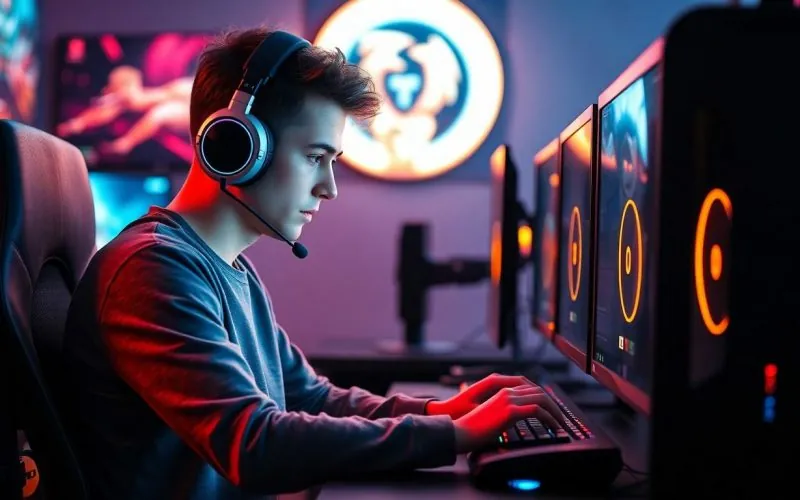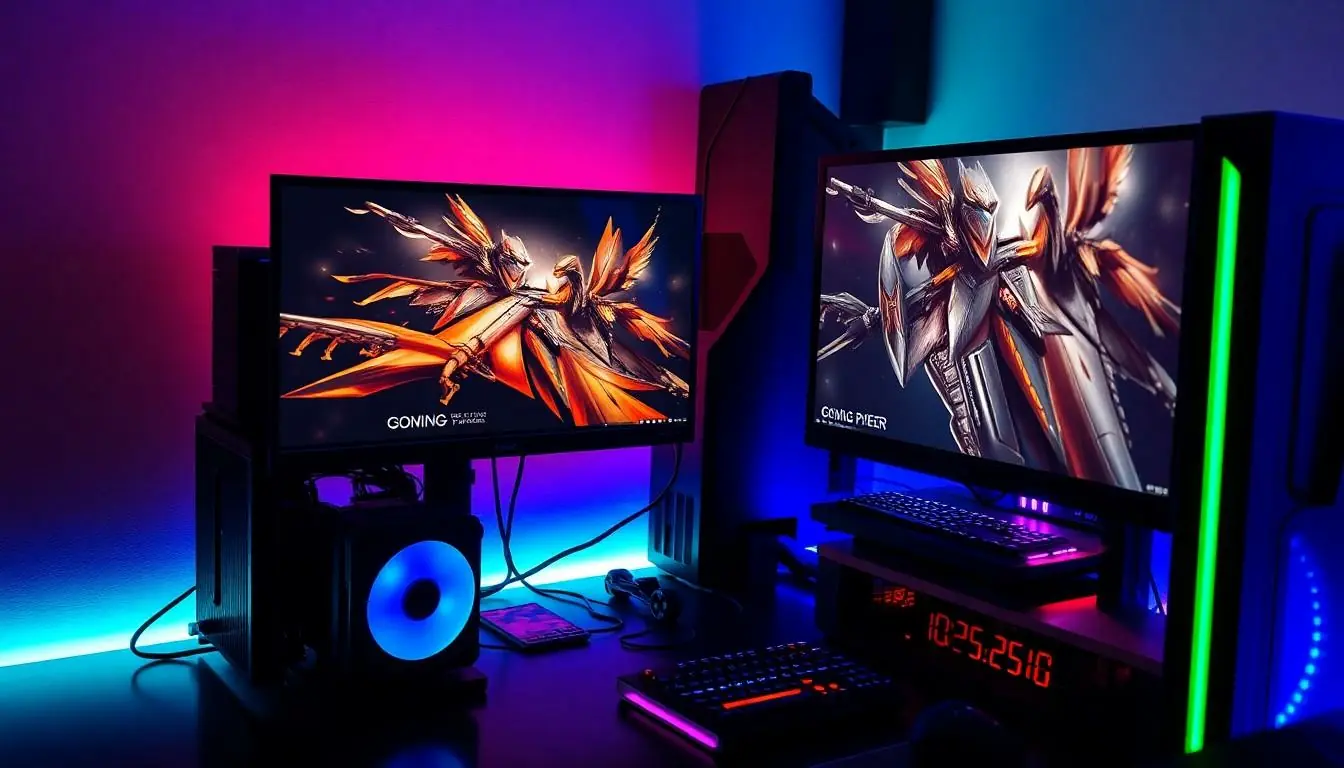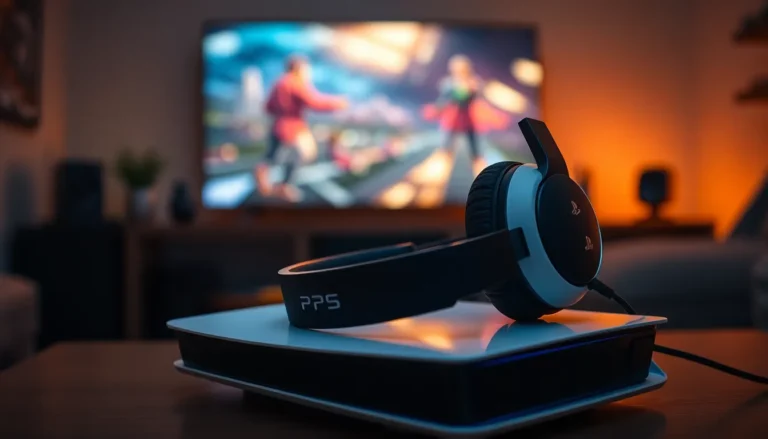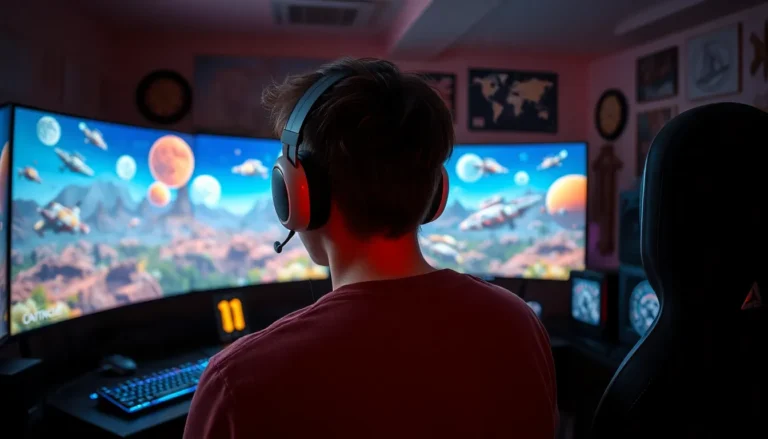Table of Contents
ToggleIn the high-stakes world of gaming, every frame counts. Picture this: you’re in the heat of battle, adrenaline pumping, and your game suddenly stutters like a toddler on roller skates. Frustrating, right? If only your PC could keep up with your skills. Luckily, improving your frames per second (FPS) isn’t just for tech wizards—it’s for anyone who wants a smoother, more immersive gaming experience.
Understanding FPS and Its Importance
Frames per second (FPS) represents the number of frames displayed by a graphics system each second. Higher FPS ensures smoother visuals and a more enjoyable gaming experience.
What Is FPS?
FPS stands for frames per second, a critical metric in the gaming world. It measures how many individual images a graphics processor can render every second. Generally, FPS can range from 30 to over 120, depending on the game and hardware capabilities. Many gamers prefer higher FPS rates since they contribute to a more fluid and responsive experience. Lower FPS, around 30, often leads to choppy visuals. A smooth gameplay experience occurs at 60 FPS or above, resulting in quicker reactions and better overall performance.
Why FPS Matters for Gaming
FPS directly impacts gameplay quality and immersion. Players notice the difference in responsiveness when the FPS is high, allowing for precise movements and actions during intense scenarios. High FPS reduces input lag, making actions feel instant. With a stable FPS, gamers experience less screen tearing and stuttering, enhancing overall enjoyment. Competitive gamers emphasize the need for high FPS to gain a tactical edge. Smooth animations and clear visuals become crucial during fast-paced action, such as first-person shooters or racing games. Higher FPS not only enhances the gaming experience but also contributes to long-term gaming satisfaction.
System Requirements and Updates
Understanding system requirements plays a crucial role in achieving better FPS on a PC. Users need to know both minimum and recommended specifications for optimal performance.
Minimum and Recommended Specs
Minimum specifications define the basic hardware needed to run a game, while recommended specs ensure a smoother experience. Every game has its own set of requirements, often listed on digital platforms. A graphics card with at least 4GB VRAM and a multi-core processor is common for many modern games. Higher specifications lead to better performance. When aiming for 60 FPS in most titles, targeting recommended specs becomes essential. Not meeting the minimum can result in lag or unplayable experiences.
Keeping Drivers Up to Date
Updating drivers significantly enhances FPS by ensuring a graphics card operates at peak performance. Software updates frequently include optimizations and bug fixes that improve gaming experiences. On a regular basis, users should check for updates from the graphics card manufacturer. Tools like GeForce Experience or AMD Radeon Software simplify this process. Updated drivers often unlock better performance and game compatibility. Regular maintenance, combined with updates, ensures a smoother gaming journey.
Adjusting Graphics Settings
Adjusting graphics settings can significantly enhance FPS on a PC. Players often find that modifying specific options leads to smoother gameplay and improved performance.
Lowering In-Game Graphics
Lowering in-game graphics settings can effectively boost FPS. Players can reduce texture quality, shadow detail, and effects to lighten the load on their graphics card. Disabling anti-aliasing creates sharper visuals without compromising performance. Additionally, turning off unnecessary visual effects, like motion blur and depth of field, enhances fluidity during gameplay. Try experimenting with presets, as some games provide “low,” “medium,” and “high” options to simplify adjustments. Each of these changes contributes to a more responsive gaming experience, particularly in fast-paced scenarios.
Tweaking Resolution and Display Options
Tweaking resolution and display options often leads to improved FPS on a PC. Lowering the screen resolution decreases the number of pixels the graphics card must process. A common practice is switching from 1920×1080 to 1600×900 or lower, which can result in noticeable performance gains. Changing the display mode from fullscreen to borderless windowed can also help optimize FPS while retaining a comfortable gaming experience. Synchronization settings like vertical sync (V-Sync) can be disabled to eliminate frame rate caps, allowing for maximum FPS potential. Each of these adjustments makes a significant impact on overall performance, ensuring a smoother and more enjoyable gaming experience.
Hardware Upgrades
Upgrading hardware components can significantly improve FPS on a PC. Consider the following key upgrades.
Upgrading Your Graphics Card
A powerful graphics card can transform gaming experiences. Investing in a model with higher VRAM, such as 6GB or more, enhances capability to handle modern games. Graphics cards from manufacturers like NVIDIA and AMD offer a range of options for different budgets. The latest models utilize advanced technologies, leading to improved frame rates. Check compatibility with existing hardware before purchasing. Upgrading the graphics card often results in immediate visual enhancements and a smoother gaming experience.
Increasing RAM Capacity
More RAM enables better multitasking and smoother gameplay. Upgrading from 8GB to at least 16GB is often recommended for modern gaming systems. A higher capacity allows games to run more efficiently, especially those that demand significant resources. Dual-channel memory configurations can further enhance performance by improving data transfer rates. Install RAM matching the existing specifications to ensure proper functionality. Increasing RAM capacity tends to lead to noticeable performance gains in demanding titles and improves overall system responsiveness.
Performance Optimization Techniques
Performance enhancements can lead to a significant increase in FPS on a PC. Implementing strategies such as overclocking and utilizing system cleanup tools can improve gameplay smoothness.
Overclocking Your GPU
Overclocking the GPU boosts its clock speed, allowing it to process more frames per second. The process involves adjusting settings in the graphics card’s software or using third-party applications. Many gamers report FPS improvements by overclocking their GPU within safe limits. Notably, monitoring temperature is crucial to prevent overheating. If the GPU runs too hot, it could lead to instability or damage. Various guides are readily available for users who want step-by-step instructions on safe overclocking. Properly executed overclocking provides noticeable gains that enhance the gaming experience.
Using System Cleanup Tools
Using cleanup tools optimizes system performance by removing unnecessary files and freeing up storage. Speedier loading times and reduced lag contribute to an improved FPS outcome. Tools like CCleaner or built-in Windows utilities can effectively handle disk cleanup tasks. Regularly cleaning the system also improves background processes, allowing resources to focus on gaming. Moreover, optimizing startup applications can enhance boot times and overall system responsiveness. Users should consider setting a routine for system maintenance to sustain performance enhancements. By implementing these cleanup practices, gamers can enjoy a smoother gameplay experience.
Conclusion
Achieving better FPS on a PC is within reach for every gamer. By understanding the importance of FPS and making strategic adjustments to both hardware and software, players can significantly enhance their gaming experience. Whether it’s tweaking in-game settings or upgrading critical components, every step contributes to smoother gameplay.
Regular maintenance and updates also play a vital role in performance optimization. With the right approach, gamers can enjoy not only improved FPS but also a more immersive and enjoyable gaming journey. Embracing these techniques ensures that players stay competitive and engaged in their favorite titles.






